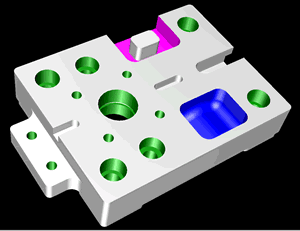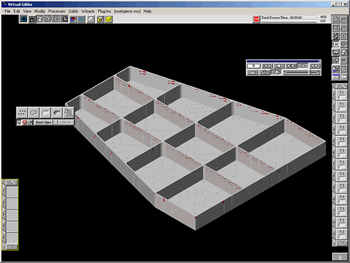Super Model Project
 The "Super Model Project" is our term for the Model
Driven Intelligent Control of Manufacturing ATP project awarded to
STEP Tools and a team of sub-contractors in October 1999. The goal of
the project was to use STEP-NC and other standards to develop an open
database of all the information necessary to design and manufacture a
part.
The "Super Model Project" is our term for the Model
Driven Intelligent Control of Manufacturing ATP project awarded to
STEP Tools and a team of sub-contractors in October 1999. The goal of
the project was to use STEP-NC and other standards to develop an open
database of all the information necessary to design and manufacture a
part.
From Print to Digital
Common to all manufacturers of durable goods, whether they are large or small or whether the product is simple or complex, is the need to build things to print. Progress has been made in replacing the print with a digital product description. Comparable progress has not been made in the Numeric Controllers used to drive production machinery and fabricate parts. These controllers are still driven by G and M codes, dating back to the 1950's, that do not adequately describe the end product, but merely specify a path of a cutting tool. The goal of the Super Model Project is to replace these codes with complete, unambiguous product models that allow organizations to build parts to print rapidly and safely.NIST and the IRB
The Super Model project demonstrated technologies to, had many valuable inputs from the Program Manager of the National Institute of Standards and Technology (NIST) and the Industrial Review Board (IRB). The program manager supervised the $3M award made to STEP Tools, Inc. by the NIST Advanced Technology Program. The purpose of this award is to overcome the technical barriers associated with building the Super Model database so that industry can take advantage of the 37% and 75% time savings that will be available when customers can seamlessly share 3D model data about a part. The Industrial Review Board is made up of leading members of the Aerospace and Automotive industries their software suppliers, and small to mid-sized machine shops in the Hudson Valley that are their manufacturing suppliers. They include representatives from Boeing, Lockheed Martin, NASA, General Electric, General Dynamics, General Motors, Daimler-Chrysler and the Department of Energy.The Three Year Plan
 In three end-of-year demonstrations, the Super Model Project
demonstrated that machine shops can read 3D design and manufacturing
data into machine tool controllers and use that information to
manufacture a part more quickly, safely and intelligently.
The first demonstration was held on
November 30, 2000 at the Benet Laboratories of Watervliet Arsenal.
The second year demonstration was held on
February 20, 2002 at the Experimental Machine Tool and Plating Company
Inc. in Troy, New York. The final demonstration
of the project was held at NASA Jet Propulsion Laboratory.
In three end-of-year demonstrations, the Super Model Project
demonstrated that machine shops can read 3D design and manufacturing
data into machine tool controllers and use that information to
manufacture a part more quickly, safely and intelligently.
The first demonstration was held on
November 30, 2000 at the Benet Laboratories of Watervliet Arsenal.
The second year demonstration was held on
February 20, 2002 at the Experimental Machine Tool and Plating Company
Inc. in Troy, New York. The final demonstration
of the project was held at NASA Jet Propulsion Laboratory.